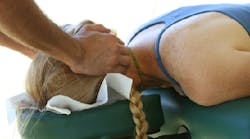I don’t know many people plan to change careers at the age of 50, but I did just that, and my only regret is not doing it sooner.
I was motivated by a number of things—a revolving door of neck and back pain first and foremost—but also a desire to work in a less hectic, stressful environment. I wanted to remain in the health-care field, but avoid the sedentary, problematic postures inherent to dentistry. Following my very first massage, the seed was sown, although I didn’t realize it right away.
From 1979 to 2006, I had enjoyed the dental hygiene profession, especially developing patient rapport, practice building, and preventative education. Guiding a fearful or tentative patient from poor to optimal oral health and transforming them into a happy, regular patient, is quite rewarding.
In turn, guiding a fearful, injured, or stressed-out client to optimal physical health, transforming them into a calmer, more focused, and regular massage client is equally rewarding. The desire to facilitate and maintain optimum overall health is but one important similarity between dentistry and massage therapy.
READ MORE | Dental hygiene career alternatives: Breaking into public health
My dental hygiene career was spent in private practices, and like most other professionals, I was cross-trained, a necessity in the event of an emergency or a staff shortage. Although my preferred role was direct patient care, stepping into other positions revealed how (and how not) to build and operate a small business. This would prove beneficial when I began my private massage therapy practice in 2007. As a small-business owner and solo practitioner now, I wear all the hats in my office, and I wouldn't have it any other way.
My injuries and path to a pain-free life
As I said, the decision to move from dental hygiene into massage therapy entered my mind at the conclusion of my very first massage in 1998. I had been seeking treatment for this recurring pain and had followed standard medical practices, including physical therapy, several muscle relaxers, rest, and ice. One provider had even suggested a steroid injection into my right elbow space. I know I'm not alone in this saga. In spite of surgeries, therapy, and shorter work days, some work in pain on a daily basis, while others have left the field.
My issues involved my cervical spine, neck and upper back muscle groups, and occasional lower back pain, and lastly lateral epicondylitis (i.e, “tennis elbow”) late in 2005. At times the neck muscle spasms, with limited range of motion, were of sudden onset and nearly debilitating. It became a vicious cycle affecting me personally and professionally. After the third or fourth bout in roughly 24 months, I sought the help of nontraditional treatment, and on the advice a trusted colleague, scheduled an appointment with a chiropractor.
The doctor was very familiar with dental professionals' physical problems. Her observations about the muscle groups involved matched that of the physicians and therapists I had seen previously. However, radiographs demonstrated shortened cervical spine spaces due to thinning discs in that region. My right forearm (my dominant side) exhibited the previously diagnosed epicondylitis inflammation, rigid extensor muscle groups, and a slight amount of weakness in my right hand compared to my left. Long story short, the eight-hour days of being chairside were taking their toll on my skeletal and muscular structure. I was slightly unnerved, but determined to avoid further episodes of pain and find a path to recovery and excellent health.
READ MORE | DO IT: 3 ways to refocus and overcome setbacks
As luck would have it, the wife of a periodontist colleague strolled into the reception area where I was awaiting the treatment plan consultation, greeted me, and very quickly calmed my nerves. If misery loves company, I was in good company! Her husband had also endured pain and range of motion issues and had arrived in chiropractic care through a similar route. After six months, he was almost completely free of pain, working full-time, and no longer worried about the possibility of an early end to a great career. Most of my nervousness and fear disappeared, and the chiropractor and I proceeded with my personal care plan.
Although cautious about seeking care outside of my comfort zone, I continued treatment with this chiropractor for almost a year, weekly at first and then monthly, and realized gradual and sustained improvement. I also learned valuable lessons about posture, stretching, breathing, and body mechanics to offset the sometimes poor sustained postural positions as a hygienist. The chiropractor suggested I have a full-body deep tissue massage with her own massage therapist. I was still dealing with maintaining proper posture at work, soreness at the end of the day, and some degree of inflexibility, and both massage therapist and chiropractor felt this type of massage would help break the cycle.
It would be the first of many sessions, but was so life-changing that I still recall what I wore that day. I certainly remember how wonderful I felt afterward. I had not felt so youthful in terms of balance and flexibility in decades, and while I'm sure endorphins played a role here, I was determined to maintain that sense of freedom and absence of pain from that point on. I just wanted to share this transformative event with others, starting with my dental colleagues, most of whom had issues of their own.
How dental hygiene helped me learn massage therapy
It would be many subsequent massage sessions (and years) before I formally enrolled in a local, privately owned massage therapy school, working part-time as a hygienist, but the spark was lit. In 2006, I had enjoyed enough great massage therapy sessions, had improved physically, even gaining an inch in height, and been free from the past neck/back issues, that I decided massage therapy was calling me.
My hygiene education and career definitely eased the transition into the massage therapy curriculum (600 hours are required in Missouri), exams, clinic, then board exams, and licensing. We are required to maintain 12 CEUs biannually, as well as malpractice and liability insurance.
READ MORE | Dental hygienist is fed up with so-called ‘full-time’ positions; another wishes to start consulting business
I thoroughly enjoyed the return to school, and the “refresher” courses in anatomy, physiology, ethics, and my time in the student clinic. Our clinic instructors were bemused by my lengthy, thorough write-ups, but understood my background in legal protective "CYA" notes from the private practice setting. I continue this habit in both of my offices.
How my career looks now
Today, I am in the ninth year of my licensed massage therapy career. In one of my practice locations, I work with two physical therapists (DPTs). I coordinate with other medical professionals and provide supportive therapy to patients undergoing intense physical therapy in order to facilitate recovery to optimal health. At my second office, I partner with a massage therapist who also changed careers after a lengthy career in business for many of the same reasons as I did. We enjoy a beautiful, calming, peaceful place to work, and endeavor to impart this energy to our clients, no matter their issue.
The similarities between hygiene and massage are many: patient/client intake forms, medical history review, physician approval for prenatal or medically compromised clients, anatomy, physiology, and pharmacology background for reference in treatment, referral, and comprehensive notation. As a solo practitioner, greeting, dismissing clients, follow-up calls, payment and rescheduling duties are mine alone. Both of my practice domains are referral-only, which has proven to be a safe and trustworthy source of new clients.
My office hours are very different from the typical dental office. I rarely see a client before 10:00 a.m., and usually finish by 6:00 p.m. My clients range in age from preteen to mid-80's, come in all shapes and sizes, in are in various states of stress, injury, post-surgery, and rehabilitation. I welcome dental professionals and other people who suffer from career-oriented repetitive injury and posture-related issues. My goal is to guide them back to optimal health in support of other therapies they may be receiving, and avoid debilitating habits or injury.
There are other welcome contrasts. My “operatory” consists of a soundproof, aromatic room with calming and pleasant music, a hydraulic massage table outfitted with a heated, plush lamb’s wool pad, covered with bamboo sheets. During even the most therapeutic (as opposed to relaxation) massage, this environment promotes a centering calm for both the client and me. Most sessions last 60 minutes, though a good portion of my clientele schedule 90 minutes or 2 hours regularly.
I'm often asked if I miss working as a hygienist. There are enough similarities that I often feel as if I never left, especially when I'm working with a client suffering from a TMJ-related issues. My dental clients, along with maintaining my license, keep me up to date as well.
Honestly though, I don't miss the hustle-bustle of my former career, or the noise, interoffice conflict, office meetings, emergencies, running behind, stressed staff, etc. I don't miss gloves, scrubs, masks, chemicals, noise, or elevator music! Most of all, I'm happy to leave behind the seated, sedentary, and fixed posture of my former career. For most of a typical massage session, I'm moving in all directions, and practice good body mechanics to avoid injury.
Although the path to my new profession started from a chronic pain issue and took time, it was so worth the effort. I work in a calm, pleasant environment, remain physically active, and help people in a meaningful yet relaxing way to attain optimal health. Massage improves everything!
Lisa M. Telthorst, RDH, BS, LMT, is a graduate of the UMKC School of Dental Hygiene (Class of 1979). She is a massage therapist in private practice at Legacy Physical Therapy and Creekside Massage Therapy in St. Louis, Missouri. She obtained her LMT certification at Healing Arts Center, St. Louis, Missouri, in 2007.







